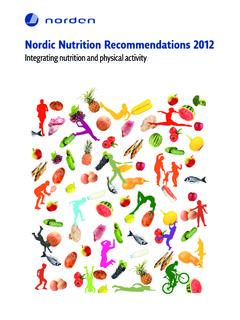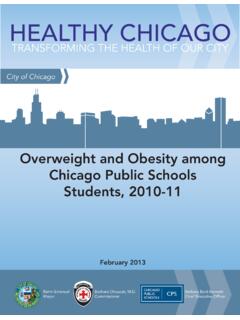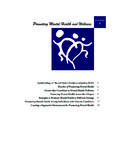Transcription of 2014 State Indicator Report on Physical Activity
1 State Indicator Report on Physical ActivityNational Center for Chronic Disease Prevention and Health Promotion Division of nutrition , Physical Activity , and ObesitySuggested Citation: Centers for Disease Control and Prevention. State Indicator Report on Physical Activity , 2014. Atlanta, GA: Department of Health and Human Services, can find more information about the State Indicator Report on Physical Activity , 2014 at: Indicator Report on Physical Activity , 20143 State Indicator Report on Physical Activity , 20143 What is the reportThe State Indicator Report on Physical Activity , 2014, presents State -level information on Physical Activity behaviors and on environmental and policy supports for Physical is already knownPeople who are physically active generally live longer and have a lower risk for heart disease, stroke, type 2 diabetes, depression, some cancers, and obesity .
2 Environmental and policy strategies such as access to safe places for Physical Activity , Physical education and Physical Activity in schools and child care settings, and street-scale and community-scale design policy can help increase Physical Activity behavior among all Americans. What are the key findingsThis Report shows that Physical Activity among adults and high school students is higher in some states than others. Overall, most states have environmental and policy strategies in place that encourage Physical Activity . How can this Report be usedThe State Indicator Report on Physical Activity , 2014, can be used to illustrate how states support Physical Activity and identify opportunities to improve access to environmental supports such as sidewalks or walking paths for active behavior.
3 What are the implications for public health practiceState health departments can work with governmental and non-governmental partners to create safe places for Physical Activity , to enhance Physical education and Physical Activity in schools and child care settings, and to support street-scale and community-scale design policy. These partnerships will likely depend on the type of activities a State chooses to focus on. For example, some State departments of health, parks and recreation, and education may work together to help communities establish joint-use agreements that allow residents to use school Physical Activity facilities after school hours. To increase residents access to safe sidewalks, State departments of health, transportation, and community organization may work together to support street-scale design for Disease Control and Prevention4 Introduction4 Being physically active is one of the most important steps that Americans can take to improve their health.
4 The 2008 Physical Activity Guidelines for Americans recommends that adults participate in at least 2 hours and 30 minutes (150 minutes) a week of moderate-intensity aerobic Physical Activity and at least two or more times a week of muscle-strengthening activities for health For additional and more extensive health benefits, adults should increase their aerobic Physical Activity to 300 minutes (5 hours) a week of moderate and adolescents should do 1 hour (60 minutes) or more of Physical Activity who are physically active generally live longer and have a lower risk for heart disease, stroke, type 2 diabetes, depression, and some Physical Activity can also help control However, only about half of adults and less than a third of youth meet aerobic Physical Activity ,4 To improve Physical Activity behaviors among residents, State health departments, other State and local government agencies, and their partners can work together to implement the Community Preventive Services Task Force s recommended environmental and policy strategies for increasing Physical Activity .
5 These strategies include 1) Creating or enhancing access to safe places for Physical Activity ; 2) Enhancing Physical education and Physical Activity in schools and child care settings; and 3) Supporting street-scale and community-scale design State Indicator Report on Physical Activity , 2014, provides information for each State on State -level supports for the three environmental and policy strategies listed above for increasing Physical Activity and Physical Activity behaviors. This Report , which can be used to inform decision makers throughout the State , shows that Physical Activity among adults and youth is higher in some states than others; and overall, most states have environmental supports such as sidewalks or walking paths in place that encourage Physical Activity .
6 Additionally, the three Stories from the Field included in the Report highlight efforts by State or local health agencies and their partners to implement initiatives that help increase Physical Activity behavior among residents. This Report shows that many State health departments, other State and local government agencies, and their partners are working to improve access and establish polices that make it easier to be physically active in communities and schools. For example, 27 states have created State -level Complete Streets policies that help to ensure that streets are safe State Indicator Report on Physical Activity , 20145for all users including pedestrians and bicyclists. In addition, 34 states provide guidance on policies for school districts or schools on walking or biking to or from , more work needs to be done to increase access to opportunities to be physically active.
7 Only 20 states provide guidance to districts or school staff on establishing joint-use agreements. No states have child care regulations that fully align with national standards for moderate- to vigorous-intensity Physical Activity for preschoolers. Additionally, nearly half of youth live in neighborhoods without parks or playgrounds, community centers, and walking paths or sidewalks. Many factors, however, play a role in improving Physical Activity and supports for Physical Activity . State health departments can continue to work with other State and local governmental and non-governmental agencies to create or enhance access to safe places for Physical Activity , enhance Physical education and Physical Activity in schools and child care settings, and support street- and community-scale design policies.
8 ID Centers for Disease Control and Prevention6 Centers for Disease Control and Prevention6 State Indicator Report on Physical Activity , 20147 Stories from the FieldMichiganComplete Streets InitiativesThe Michigan Department of Community Health partnered with Healthy Kids, Healthy Michigan,a statewide coalition representing more than 120 organizations, to support urban design that increases access to places to be physically active by implementing its Complete Streets Initiative. The Michigan Department of Community Health s Complete Streets Initiative included statewide efforts to educate and promote the need for local Complete Streets ordinances. Community members who witnessed the effects of local Complete Streets ordinances supported the statewide Complete Streets measure.
9 Michigan policymakers introduced and adopted a statewide Complete Streets resolution. After two years of work, the State -level Complete Streets legislation was passed on August 1, 2010. Under this legislation, the Michigan Department of Transportation will consider all legal users of the roads, from public transportation riders and motorists, to bicyclists and pedestrians when considering transportation design. As of 2013, at least thirty-eight Complete Streets policies have been implemented throughout the State and more than two million Michigan residents live in a community with a Complete Streets resolution or ordinance. 7 State -level Complete Streets policies formalize a State s intent to plan, design, and maintain streets so they are safe for all users of all ages and for Disease Control and Prevention8 BostonBike-to-Market Program The Bike-to-Market program in Boston, Massachusetts is a community health program established by bicyclist organizations, public health researchers, and city representatives.
10 The program provides opportunities for community members to safely ride bikes for transportation. The program also encourages Boston residents to bike to famers markets. The Bike-to-Market program increased local access to bicycles for Bostonians, decreased bicycle theft, improved cyclists knowledge about bicycle safety, and increased civic engagement in street redesigns for bicycle and pedestrian safety. The program bridged community interests in bicycling as transportation with access to farmers markets by providing free bike services to children and adults at various farmers markets in Boston neighborhoods that lack a bicycle repair shop. These included services such as bicycle repair, safety equipment and education, and bicycle lock the Bike-to-Market program began in 2010, it has repaired over 1,600 bicycles and expanded the program from 9 to 16 farmers markets.















